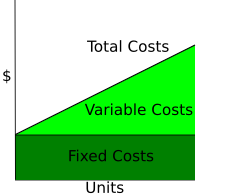 Starting at the bottom are fixed costs which are basically business expenses that are not dependent on the level of production or sales. They tend to be time-related, such as salaries or rents being paid per month. You can think if of these costs as the baseline operational expenses of running your business, or in the case of IT, the cost of maintaining your core technical infrastructure.
Starting at the bottom are fixed costs which are basically business expenses that are not dependent on the level of production or sales. They tend to be time-related, such as salaries or rents being paid per month. You can think if of these costs as the baseline operational expenses of running your business, or in the case of IT, the cost of maintaining your core technical infrastructure.In a sense, a key economic driver for the use of remote capacity (cloud computing) is in its ability to convert a fixed cost into that of a variable cost or a cost which is volume-related (paid per use / quantity). This seems to be the industry standard way to justify the use of cloud computing.
Then there is the question of capital expenditures (CAPEX) which are expenditures creating future benefits. For example, the money Amazon is spending on building out their web services infrastructure. One way to look at cloud computing is as method of deferring CAPEX. The theory is generally stated like this, by utilizing someone elses infrastructure you can choose pay only if and when you need additional capacity as a variable cost. It's also interesting to note that capital expenditures can have some tax benefits because they can be amortized or depreciated over the life of the assets in question. So potentially the ability to create a hybrid cloud model that uses both exisiting resources and remote resource may actually be very compelling to larger established businesses mostly for tax benefits. For example, a large hosting firm may choose to recycle used dedicated servers into their cloud offering thus making money on both sides of CAPEX and variable costs. (This assumes the business is profitable)
The next motivating factor is that of the operational expenditure or OPEX which is an on-going cost for running a product, business, or infrastructure. I like the wikipedia OPEX example, the purchase of a photocopier is the CAPEX, and the annual paper and toner cost is the OPEX. In the cloud world OPEX is considered great unknown variable, it may be cheaper upfront to use a cloud provider thus reducing your CAPEX, but long term it may cost more to manage your remote assets because of increased software complexity, security as well as a variety of other reasons.
This bring us to Total cost of ownership (TCO) which is a financial estimate designed to help consumers and enterprise managers assess direct and indirect costs. TCO is typically the way a IT vendor validates their particular costs over a competitor, such as Mircosoft Vs Linux. The argument Microsoft used was that Linux is cheaper upfront, but is much more expensive to manage down the road. Therefore the TCO of Microsoft Vs that of Linux is much lower. TCO is very difficult to quantify and can be easily "gamed" and therefore should be looked rather sceptically.
At the end of the day, for most businesses it's cheaper to use someone elses infrastructure then is to use your own. At it's heart, this is the key reason to use the cloud.

